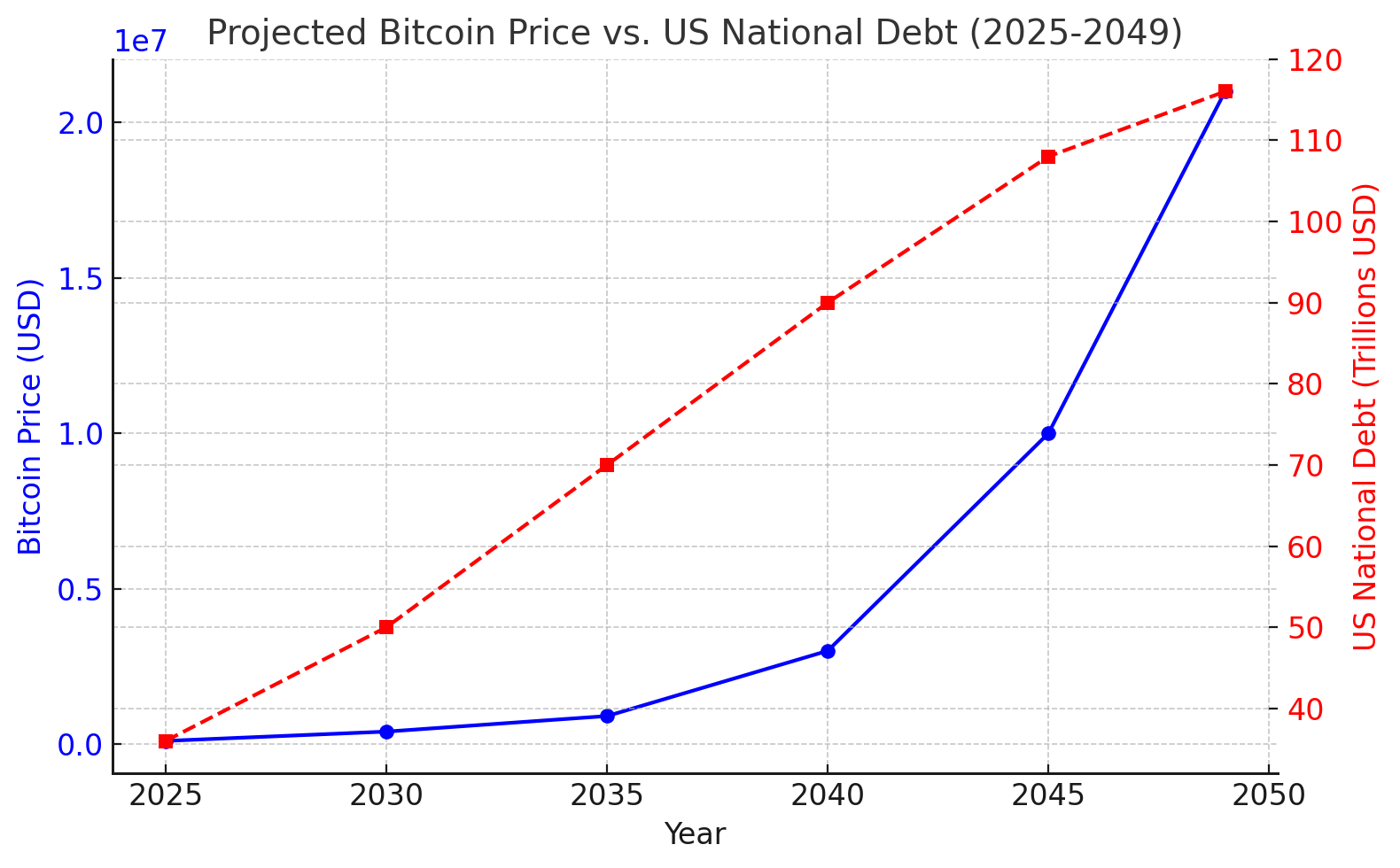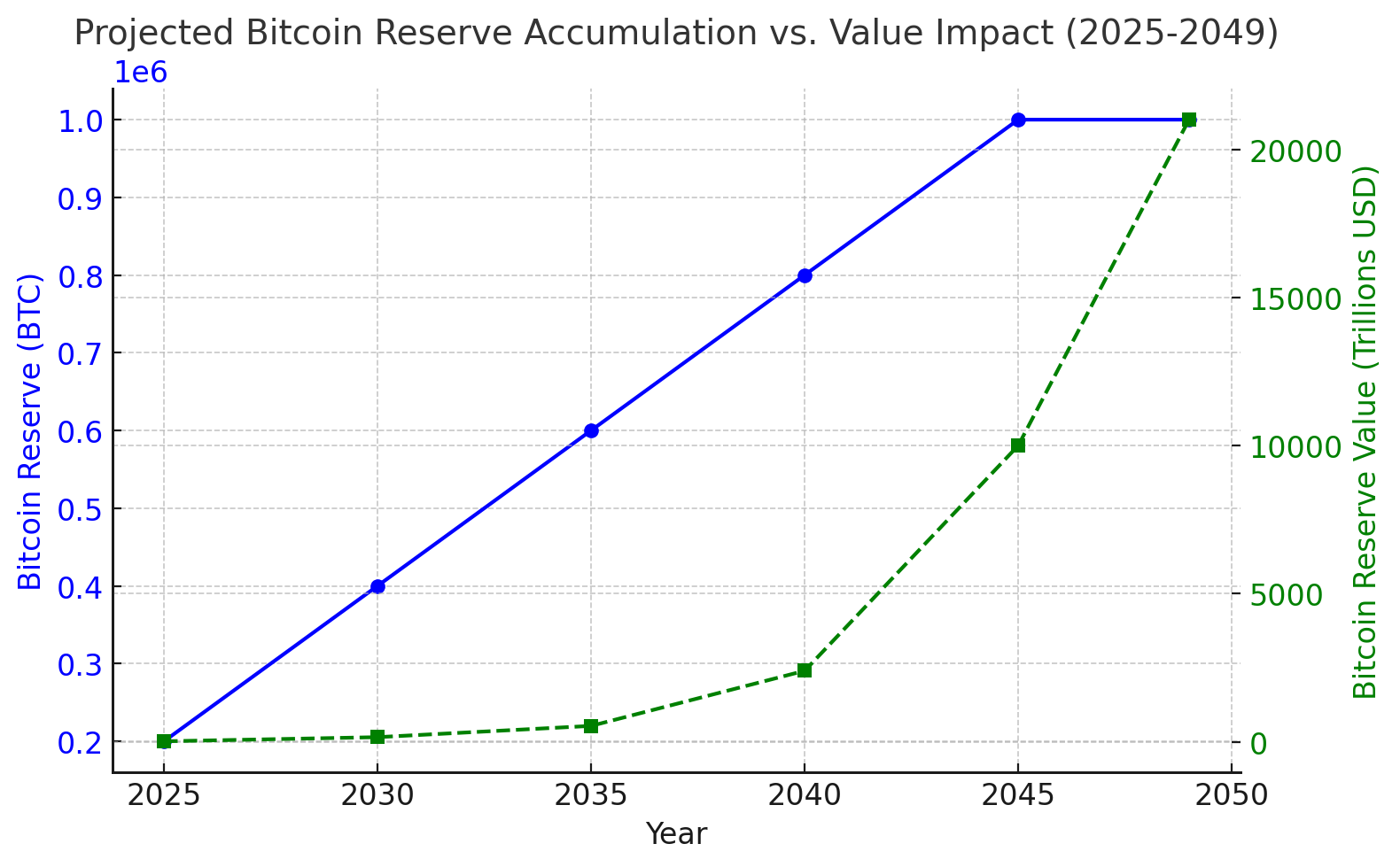According to the source, an investment firm, VanEck, suggests that the United States could significantly reduce its national debt by establishing a strategic Bitcoin reserve. This concept, inspired by Senator Cynthia Lummis’ BITCOIN Act of 2024, envisions the U.S. Treasury acquiring up to 1 million Bitcoins over five years to bolster the nation’s financial standing.
- The Proposal: Accumulating Bitcoin to Offset National Debt
- Senator Lummis’ Advocacy for a Bitcoin Reserve
- Economic Implications and Feasibility
- State-Level Initiatives and Global Perspectives
- Challenges and Considerations
- Conclusion
- FAQs
- 1. How could a Bitcoin reserve help reduce the U.S. national debt?
- 2. What is Senator Cynthia Lummis’ role in this Bitcoin reserve proposal?
- 3. What are the risks of the U.S. government holding Bitcoin as a reserve?
- 4. Has any U.S. state or country adopted a Bitcoin reserve?
- 5. What would happen if Bitcoin’s price did not rise as projected?
- Glossary of Key Terms
The Proposal: Accumulating Bitcoin to Offset National Debt
VanEck’s analysis presents a scenario where the U.S. government embarks on a systematic acquisition of Bitcoin starting in 2025. The plan involves purchasing 200,000 Bitcoins annually over five years, with an initial acquisition price of $100,000 per Bitcoin. Assuming a compounded annual growth rate (CAGR) of 25%, the value of Bitcoin could escalate to approximately $21 million per coin by 2049. Under these projections, a reserve of 1 million Bitcoins would equate to $21 trillion, potentially offsetting 18% of the projected $116 trillion U.S. national debt by that time.

Senator Lummis’ Advocacy for a Bitcoin Reserve
Senator Cynthia Lummis, a prominent advocate for cryptocurrency integration into the U.S. financial system, introduced the BITCOIN Act in July 2024. The legislation proposes the creation of a Strategic Bitcoin Reserve, mandating the Treasury to acquire and hold Bitcoin as a long-term asset. Senator Lummis argues that such a reserve could serve as a hedge against inflation and currency devaluation, bolstering the nation’s economic resilience.
Economic Implications and Feasibility
While the proposal offers an innovative approach to debt reduction, it hinges on several critical assumptions:
Bitcoin’s Appreciation: A sustained 25% annual increase in Bitcoin’s value is ambitious, considering the cryptocurrency’s historical volatility and market unpredictability.
Debt Growth Rate: The projection assumes a 5% annual growth in national debt, escalating from $36 trillion in 2025 to $116 trillion by 2049.
Market Dynamics: The government’s large-scale entry into the Bitcoin market could influence prices, potentially leading to market distortions.
Critics also highlight the opportunity cost of allocating substantial public funds to a highly volatile asset, suggesting that such investments could be directed toward more stable and productive avenues.

State-Level Initiatives and Global Perspectives
The concept of governmental Bitcoin reserves is gaining traction beyond the federal level. At least 18 U.S. states have introduced bills proposing the establishment of state-level digital asset reserves. Collectively, these initiatives could lead to the acquisition of approximately 247,000 Bitcoins, representing an investment of around $23 billion. This movement reflects a growing recognition of cryptocurrencies’ potential role in public finance.
Internationally, central banks are also exploring the integration of Bitcoin into their reserves. For instance, the Czech National Bank has initiated studies to assess the feasibility and implications of including Bitcoin in its reserve assets, signaling a shift toward broader acceptance of digital currencies in traditional financial systems.
Challenges and Considerations
Despite the potential benefits, several challenges must be addressed:
Regulatory Uncertainty: The evolving regulatory landscape for cryptocurrencies could impact the feasibility and legality of such reserves.
Market Volatility: Bitcoin’s price fluctuations pose risks to the stability of national reserves.
Public Perception: Gaining public and political support for investing taxpayer money in cryptocurrencies may prove challenging.
Conclusion
VanEck’s proposal to utilize a strategic Bitcoin reserve as a tool for national debt reduction presents a novel intersection of digital assets and public finance. While the projections are optimistic and contingent on multiple variables, the discussion underscores the increasing relevance of cryptocurrencies in economic policy considerations. As both federal and state governments and international entities explore this frontier, the outcomes could significantly influence the future of financial governance and debt management.
FAQs
1. How could a Bitcoin reserve help reduce the U.S. national debt?
VanEck suggests that by accumulating 1 million Bitcoins over five years, the U.S. could benefit from Bitcoin’s price appreciation, potentially offsetting 18% of the projected national debt by 2049.
2. What is Senator Cynthia Lummis’ role in this Bitcoin reserve proposal?
Senator Lummis introduced the BITCOIN Act, advocating for a Strategic Bitcoin Reserve to strengthen the U.S. financial system and hedge against inflation.
3. What are the risks of the U.S. government holding Bitcoin as a reserve?
The key concerns are Bitcoin’s volatility, regulatory uncertainties, and potential market disruptions. Critics argue that taxpayer funds should not be invested in such a speculative asset.
4. Has any U.S. state or country adopted a Bitcoin reserve?
At least 18 U.S. states are considering digital asset reserves. Internationally, the Czech National Bank is studying Bitcoin’s potential as a reserve asset.
5. What would happen if Bitcoin’s price did not rise as projected?
If Bitcoin underperforms or crashes, the reserve could become a financial liability, adding to the national debt rather than reducing it.
Glossary of Key Terms
Bitcoin Reserve – A strategic holding of Bitcoin by governments or institutions as a financial asset.
VanEck – A major investment firm proposing the U.S. government acquire Bitcoin to offset the national debt.
National Debt – The total amount of money a government owes, including domestic and foreign borrowing.
BITCOIN Act – A proposed U.S. law advocating for the creation of a Strategic Bitcoin Reserve.
Compounded Annual Growth Rate (CAGR) – A metric estimating the annual growth of an investment over time.
Inflation Hedge – An asset used to protect against the devaluation of fiat currency (e.g., Bitcoin, gold).
Regulatory Uncertainty – The lack of clear government rules or policies surrounding cryptocurrencies.
Market Volatility – Large and unpredictable price fluctuations in financial markets, particularly in crypto.
Opportunity Cost – The potential benefits lost when choosing one investment over another.
Strategic Asset – A financial holding meant to strengthen economic security, often held by governments.



















































































































